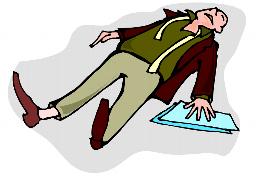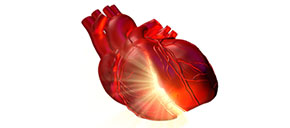Syncope
Overview
 Syncope is a sudden loss of consciousness, or fainting. It can occur for a myriad of reasons related to low blood pressure, either alone or in association with an inappropriate slow heart rate (bradycardia) or pauses, or a tachycardia (supraventricular vs ventricular). It is estimated that at least one-third of the population will suffer a syncopal spell at least once in their lifetime. It affects 1 million Americans a year and accounts for 3% of all ER visits and 6% of all hospital stays. It is a sudden syncopal episode, with no warning and without explanation that should prompt further immediate medical investigation.
Syncope is a sudden loss of consciousness, or fainting. It can occur for a myriad of reasons related to low blood pressure, either alone or in association with an inappropriate slow heart rate (bradycardia) or pauses, or a tachycardia (supraventricular vs ventricular). It is estimated that at least one-third of the population will suffer a syncopal spell at least once in their lifetime. It affects 1 million Americans a year and accounts for 3% of all ER visits and 6% of all hospital stays. It is a sudden syncopal episode, with no warning and without explanation that should prompt further immediate medical investigation.
Noncardiac causes
Syncope will be delineated here as noncardiac vs cardiac. The noncardiac episodes are the most common. Vasomotor syncope can occur when blood pools in the legs leading to a drop in the blood pressure and blood supply to the brain, with resultant loss of consciousness. This pooling of blood in the lower veins can occur when standing if the body fails to constrict those vessels as a result of dehydration, medication effect, or autonomic nervous system disease. This is generally known as orthostatic hypotension. A second form of vasomotor syncope is a result of the vasovagal (neurocardiogenic) reflex. A variety of stimuli including pain, emotions, heat, urination/defecation, yawning, and nausea can lead to an inappropriate reflexive response with pooling of blood in the legs and a varied heart rate response (typically inappropriate slowing).
Cardiac causes
Cardiac syncope is the most dangerous type of fainting, typically caused by an abnormal heart rhythm (arrhythmia). This can occur with inappropriate bradycardia (slow heart rhythm) with disease of the native conduction system. This can include the previously discussed sick sinus syndrome and AV block. These conditions can be related to the natural effects of aging, while others may be secondary to medications or myocardial damage (i.e, heart attack).
Tachyarrhythmias (heart rhythms >100 beats per minute), whether ventricular or supraventricular, can also lead to cardiac syncope. Supraventricular tachycardia rarely causes syncope and a thorough evaluation is necessary in this situation to rule out a more dangerous cause. Ventricular tachycardia and fibrillation can cause syncope and are potentially life-threatening conditions. A thorough medical history is necessary.
Diagnosis
A thorough medical history and physical exam is paramount. Vasomotor syncope (noncardiac) can have typical presentations that make cardiac causes less likely. A complete exam with sitting and standing blood pressures in both arms is typically performed. A special study, known as a “tilt table test”, may be performed by your physician if he or she suspects vasomotor insufficiency. Patients with a history of coronary artery disease and myocardial infarctions are clearly at an increased risk of developing ventricular arrhythmias. Your physician will try to capture these episodes with an outpatient monitoring device, including a Holter or Event monitor if frequent. In addition, an assessment of your heart structure and function with a cardiac echocardiogram (ultrasound) or MRI is often typically pursued. An exercise stress test may also be beneficial. If you have evidence of a tachycardia-related mechanism, your physician may pursue a diagnostic electrophysiology study (EPS) to investigate your cardiac conduction system and to determine if you have any provocable tachyarrhythmias.
Treatment of syncope depends on the cause. Vasomotor syncope can be treated with medications and avoidance of triggering situations via specific maneuvers. Most patients do get some relief, but not complete elimination of episodes. Treatment of cardiac-related syncope is tailored to the underlying mechanism. Bradycardia, or slow heart rates, typically related to sick sinus syndrome or AV block can be treated with a pacemaker if necessary. Supraventricular tachycardias can be treated with medications, or catheter ablation. Ventricular tachycardias can also be approached with medications, but typically either a catheter ablation (in benign forms) or an ICD is also necessary. Those patients with inherited causes of ventricular tachycardia including long QT syndrome, Brugada syndrome, short QT syndrome, catecholaminergic polymorphic VT syndrome, and idiopathic familial syndromes will have their treatment tailored accordingly.





 Silver Spring Office
Silver Spring Office  DC Office (at Providence Hospital)
DC Office (at Providence Hospital)  Hagerstown Office
Hagerstown Office